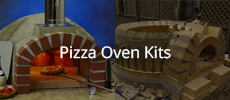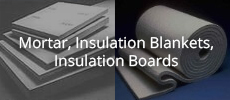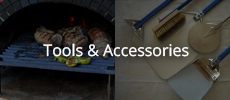I cut some hollow bricks lengthwise and used them to set the cement board vertically against the oven sides. Once I mortared these base bricks into place, the actual laying of the barrel walls was pretty easy to do...just set each brick half up against the board and presto -- straight & perfectly vertical
 . I did put in a few little pieces of pink fiberglass between the perlcrete sided and the cement board to allow for a little air flow (and to allow a little expansion room for the contained dome...if necessary during firing).
. I did put in a few little pieces of pink fiberglass between the perlcrete sided and the cement board to allow for a little air flow (and to allow a little expansion room for the contained dome...if necessary during firing).When I got to the top curve, I put some pink insulation over the top to act as a cushion and to let some air flow between the oven and the brick facade. I inserted some metal lath between the perlcrete and cement board. The lath was curved up and over the dome where it went into the other perlcrete/cement board. Obviously, the front and the back of the lath needed some extra support where the dome curved down (and the barrel would not
 )...a couple of brick chips strategically placed did the trick.
)...a couple of brick chips strategically placed did the trick.Once I cut the single line of bricks to start the top curve on each side, I was simply planning to alternately lay split brick courses up from each side. Hopefully I'd meet in the middle up on top and not have to cut slivers of bricks to "span the gap" (also the top I figured would be where the joints would be least visible).





 . I even had some half sheet pans positioned to the sides of the chimney before I figured out how to flash it with the rest of the metal roofing. (Fourth picture shows how I put up some roof edge flashing into the chimney brick mortar to provide a good drip zone around the chimney.) I was pretty concerned that a freak wind would take off the shaky structure, so that’s where the nylon rope and cement blocks came in. Problem was that the metal roof and the big swings in day/night temperatures in our winter caused a LOT of condensation and consequent dripping onto oven. I mean it all got sopping wet within a week...never saw that coming!
. I even had some half sheet pans positioned to the sides of the chimney before I figured out how to flash it with the rest of the metal roofing. (Fourth picture shows how I put up some roof edge flashing into the chimney brick mortar to provide a good drip zone around the chimney.) I was pretty concerned that a freak wind would take off the shaky structure, so that’s where the nylon rope and cement blocks came in. Problem was that the metal roof and the big swings in day/night temperatures in our winter caused a LOT of condensation and consequent dripping onto oven. I mean it all got sopping wet within a week...never saw that coming! 

Leave a comment: